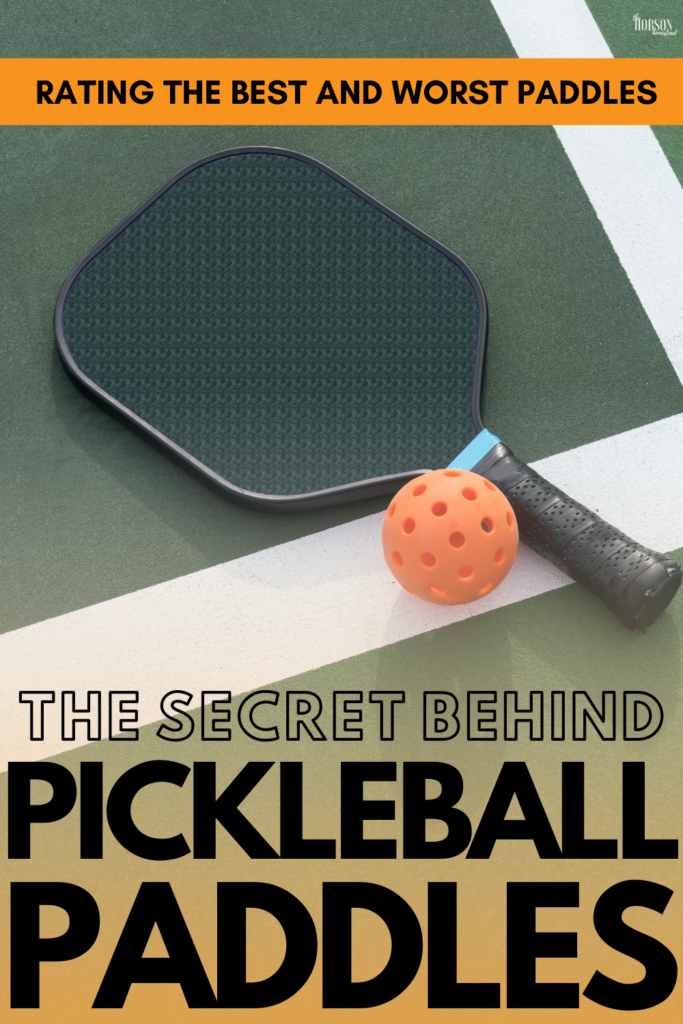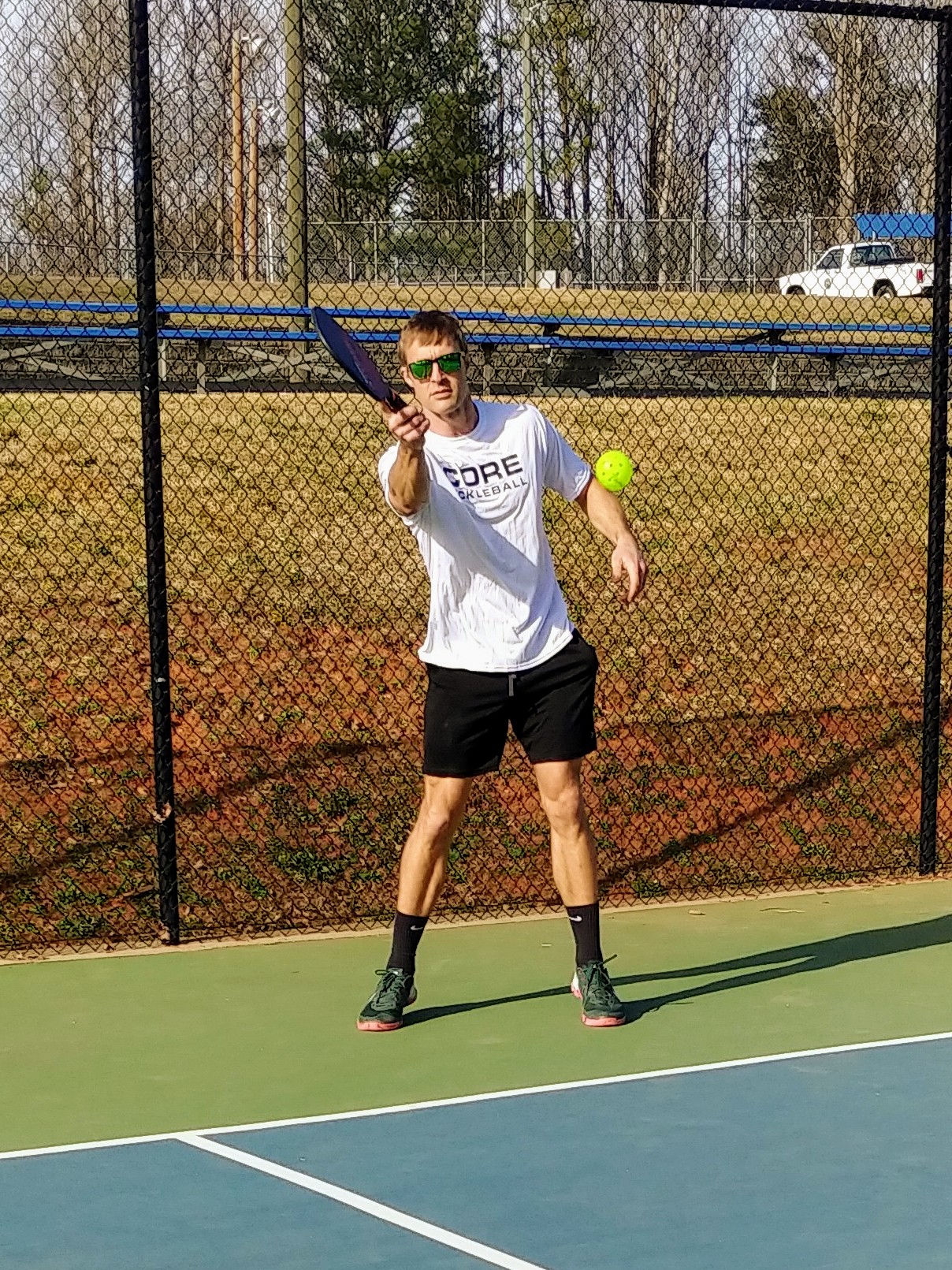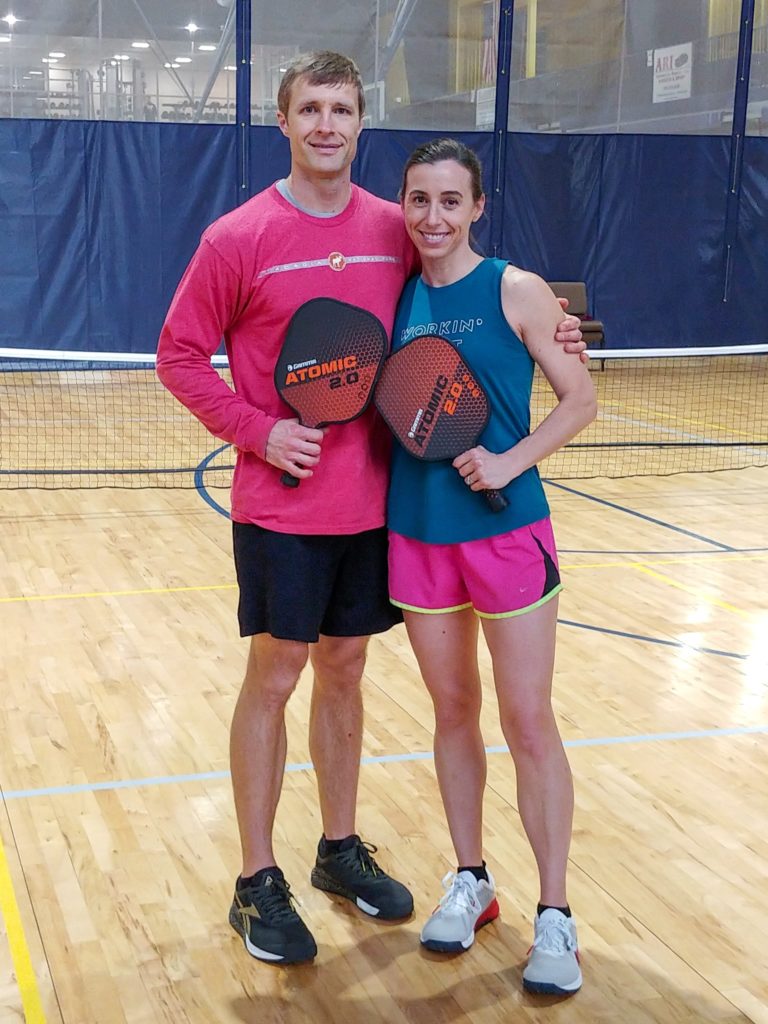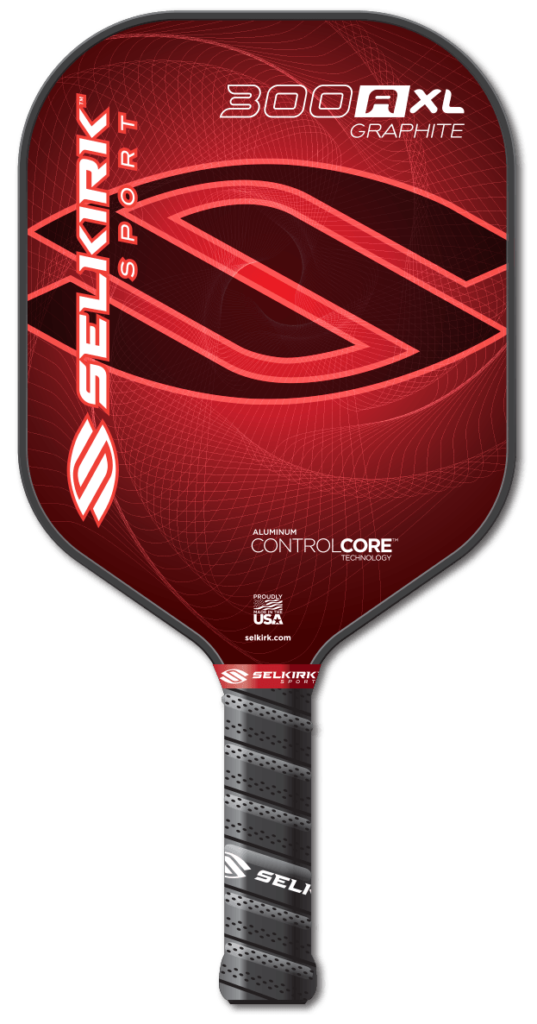Price doesn’t always equal performance when it comes to pickleball paddles. Learn the secrets of paddle composition and which pickleball companies come out on top.
Pickleball paddles are like personalities; everyone has one and they are all different. If you believe the company websites, they all make the best paddle with the most power and ultimate touch backed by the proven success of pros. But what’s the truth?
I spent a few weeks personally playing with several pickleball paddles to separate true performance from marketing hype. After vigorous testing against a diverse group of elderly senior-citizens, my results showed that there’s a lot of misleading information from paddle manufacturers and price doesn’t equal performance. Let’s dig into the crazy, oversaturated pickleball paddle market and get filthy uncovering some dirty secrets.

As an obsessive-compulsive entrepreneur who spent 18 months developing a machine to make chalk blocks, I have a unique skill-set that drives me to investigate certain industries like pickleball (and chalk). The more I read about pickleball gear, the more I realized something smelled like a rat.
Chinese OEM manufacturers private label the overwhelming majority of pickleball paddles on the market. In fact, most of the well-known pickleball brands are simply importing the same paddles with a different graphical face, which you could easily buy for half the price on Alibaba. Oops, I just ruined about a dozen small businesses and pulled down the pants on your “professional paddle,” sorry guys.
The first sign that companies are ordering from overseas is that they tend to focus on non-performance aspects of their equipment. Statements like “Personalize your paddle and stand out in the crowd!” or “The ultimate paddle for beginners to pros!” are dead giveaways. As fast as pickleball is growing, there is a rush of money-hungry starving and desperate people willing to throw cash into weak business ideas and hope they capitalize off of brainwashed suckers.
Don’t believe the hype.
If a company can’t explain why its product is superior in crystal clear detail with data to back it up, the company is most likely buying cheap junk from China and putting it into an expensive box to sell on Amazon.
Now that we’ve eliminated the bottom-feeders, let’s examine the top five companies and their equipment.
The first sign of a good company manufacturing performance products is that they manufacture in the US. Why? Because it’s such a pain in the rear to make stuff in America, only companies focusing on crafting performance products under strict guidelines would suffer through the hassle when they could easily outsource all the headaches to China.
Let’s first look at a handful of popular Amazon imports, then evaluate five companies that make their products in the US.
Cheap Imported Pickleball Paddles for Under $50
My wife and I began playing outdoor singles pickleball during quarantine and hitting hard to counteract the swirling wind. The random gusts made playing the net difficult. Dinks were erratic and third shot drops non-existent, so we defaulted to driving the ball.

Our first pickleball paddles were a set of Franklin Composite paddles, weighing in at a whopping 12 oz. each! It was like swinging a baseball bat at an acorn and we really had some power (and sore arms)! But eventually quarantine ended and we began playing indoors, where we realized a thick, heavy $15 pickleball paddle wasn’t adding anything to our non-existent finesse game. So the search began to find a paddle with more “touch” that felt less like a block of wood.
This led me to a slew of cheap, Chinese-made pickleball paddles from Amazon with various silly names like Niupipo, GRM, and A11N, all of which perform about as well as you would imagine. None are especially bad per se, but none are better than the $10 paddles you could buy from Alibaba. Plainly stated, they are private labeled throwaway paddles that lack power and have dead spots with no accuracy in placement of shots.
Any details, descriptions and reviews on Amazon are totally fake, as the weights are usually drastically different than what’s stated—and I bet if we cut them open, we’d find some low-performance plastic at the core. If you play pickleball a few times a year or once on vacation at the beach, grab a $25 import paddle from Amazon, then store it in your closet till next year.
Otherwise let’s talk about real pickleball paddles from real companies.

American-Made Performance Pickleball Paddles
This is where the party gets interesting. There are several companies that dominate the performance pickleball space and all of them manufacture in the US:
- Gamma (Atomic 2.0 Review)
- Paddletek (Tempest Wave Pro and Rally Graphite Power 5.0 Reviews)
- GearBox (GX5, GX6 and CP7 Reviews)
- Selkirk (Prime S2 and 300A XL Reviews)
- Third Shot Drop (No reviews)
- Vulcan (No reviews)
- Prolite (No reviews)
- Engage (No reviews)
- ProKennex (No reviews)
Why didn’t I review pickleball paddles from TSD, Vulcan, Prolite, Engage or Prokennex? For starters, none of these companies offered a demo program and I would NEVER buy a paddle without trying it first. The second reason was because these paddles were sufficient to discover the secrets of the industry and unveil the performance specialties of each type of paddle. But hey, if they want me to review their paddles, by all means send them over and I’ll run them through the gauntlet.
Let’s drop a huge truth-bomb right now and save you some reading:
All pickleball paddles use the same three cores (aluminum, nomex and polymer) and same three surfaces (carbon fiber, graphite and fiberglass composite).
Every paddle on the market has slightly different variations or small innovations of these three fundamental materials. The only exception are the GearBox paddles, which use a patented carbon fiber rod technology that I’ll explain later.

Please understand that there is minimal differences in paddles other than the thickness of the core material, the shape of the paddle, the length of the handle or a miniscule weight variation, none of which alter performance significantly. Essentially, you could buy hundreds of “different” paddle models that were crafted in almost exactly the same manner using the same materials. Of course, each brand of paddle comes with an exciting name for its technology such as Neucore, SRT Core, SensaCore, GelTech or X6 Core. But after using different paddles with the same core structure and surface material, there is no discernable difference in performance, regardless of the fancy name given.
But wait, read on because paddles can affect your game. However, the uniqueness of a paddle is not what the websites try to sell you. The real performance of a paddle comes from the core material.
Core Differences in Pickleball Paddles
Nomex Core
My first performance paddle was the Gamma Atomic 2.0 with Nomex Core and Fiberglass Composite face. I chose this paddle because it was known as the hardest-hitting power paddle available on the market with the Nomex Core, 8.5oz heavy weight and a medium touch surface. It did not disappoint!
This thing swings like a hammer and puts your opponent into tough situations as you bomb shots across the net—even in heavy wind! And if you have any wrist action at all, the ball will spin and move like it’s possessed! I tend to use topspin for forehand shots with the occasional slice shot for returns, and this bad boy paddle creates easy points and tough returns as the ball has insane velocity and stupid spin. I’ve got a nasty, fast-spinning serve and this paddle gives me consistent aces and my opponents constant headaches.

The sweet spot is large and without a plastic edge-guard, you can even mishit the ball and it comes off fine. At the net, the Atomic 2.0 is just ok and a little tough for accurate placement due to the fact that the ball bounces off with extreme momentum. After quite a few doubles matches where dinks decided the winner, I started looking for a more touchy/feely paddle. But overall, this paddle was a winner if you like to drive the ball instead of drop and dink.
Update: Fast forward several weeks later and I used this paddle in several doubles matches and felt like the accuracy had improved because my touch had improved. If you have the ability to control the paddle with soft hands, then this paddle is a winner. I’ll give it 8/10. I would have given it a 9/10, but it lost points because it’s not made in the US (only the higher end Gamma paddles are made in the US). This is an amazing paddle and is surprisingly superior compared to paddles twice the price.
Overall 8/10 Power Paddle
Aluminum Core
The Selkirk 300A XL is an older model paddle because no one currently makes aluminum core paddles other than Third Shot Drop Sports custom paddles. The aluminum core was known as the ultimate accuracy core and was huge in the 2010s with pros, but aluminum faded in popularity due to the discovery of a supposedly “advanced” core material called polypropylene (polymer). Another drawback to the aluminum core that led to its demise was the tendency for the paddles to dent with harder balls or from hard-hitting players.

All that being said, the aluminum core is highly superior to the polymer cores in my experience. If you haven’t played with an aluminum paddle, get one fast! It’s like swinging an old tennis racquet with rubber band strings and you can dink and place the ball with such accuracy, your opponents will think you just graduated from a pro pickleball camp. Does it lack power? Sure. But so does a weak hitter with a power paddle. Can you drive the ball with velocity using an aluminum paddle? You betcha, just swing with more force and don’t be afraid to use some muscle!
Hitting the plastic edge-guard, I did have a few balls that went haywire. But occasionally whacking your partner in the face with the ball from a mishit is part of the fun! I’ll give this paddle an 8/10 with a point subtracted for the silly and unnecessary edge guard. Otherwise it is fantastic with little or no wind or for indoor playing.
Overall 8/10 Accuracy Paddle
PolyCore
The majority of paddles now use a polymer core, likely because it’s cheaper and has more power than the aluminum core paddles and more touch than the nomex paddles. You could say that polycore paddles are a good mix of power and touch, but you could also say they are lacking in both power and touch comparatively.

I did extensive testing on several models of polycore paddles, including the Paddletek Tempest Wave Pro (overall 6/10 All-Around Paddle), the Rally Graphite Power 5.0 (a private labeled Paddletek, shh it’s a secret) and the Selkirk Prime S2 (4/10 Forgettable Paddle).
My general thoughts are that the polycore paddles—without exception—are forgettable paddles with no exceptional performance aspects. For instance, I liked the Tempest Wave Pro because it allows for solid hitting, good net-play and great spin action, but it also frustrated me with the lack of power compared to the Atomic 2.0 and lack of accuracy when compared to the 300A XL.
The Rally Graphite Pro was a $70 paddle similar in performance to the Tempest, but with a handle so short it bugged me to death during matches. It was my first-choice paddle for a couple weeks until I finally got fed up with the stubby handle and the lack of power.

The Selkirk Prime S2 was the worst of the bunch with weird awkward hits and no discernible advantages in either power or touch. Since Selkirk is the largest and most-respected brand of Pickleball paddles, I was hugely disppointed in the Prime S2. Why would Selkirk discontinue a paddle (300A XL) universally loved with hundreds of 5-star reviews, used by dozens of pros to sell a piece of mediocre tech like the Prime S2? I can only speculate the accounting department had a conversation with the owners containing the words “higher margins” and they took the bait.
All the marketing hype and professional endorsements in the world can’t overcome mediocre technology. Sorry, you might think plastic cores are the future and maybe you like to swing an average paddle, but not this guy! I want something BETTER!
GearBox Carbon Fiber
The only company selling a substantially different product is GearBox. The company compresses carbon fiber tubes as the core with a carbon fiber surface, which creates a unique and patented paddle that stands out from the pack. I tested the GX6 (long) and GX5 (wide) models and a polycore model CP7.

Their CP7 polycore paddle was similar in performance to the other group of polycore paddles and was good, but forgettable. I kept hitting harder and harder and working more diligently to place the ball, but eventually got frustrated again with the lack of specialization.

Then I pulled out the GX5 wide paddle. Immediately my brain said, “What the heck is this thing! It’s like swinging a piece of plywood!” and I proceeded to hit into the net and knock balls out by the dozen as my partner quietly faked an injury. Undeterred, I kept swinging the GX5 until I could get a freakin’ ball in play and eventually, I was hitting winners! After several moderately successful games, I noticed the handle was short and I was fidgeting way too much during play.
I revisited the pickleball bag and pulled out the GX6 long with a massive 5-inch handle. What kind of alien hive-mind designed this contraption? I immediately noticed that with my 6’2” wingspan and this insanely long paddle, I was poaching shots from my partner to the extent my opponents thought I was playing singles! I had to give warning to the folks in the next court over because I might decide to hit their balls too! But oh man does it feel good to have some barely-legal length in your hands!
Dinking was interesting because the paddle is so hard you have to gently caress the ball after taking it out to dinner first. And hitting hard shots or spin takes some practice because the GX6 is unforgiving in the hands of an intermediate player. The choice for any pickleballer rated under 4.0 is either get better or get a new paddle. Of course, GearBox customer service claimed that the paddle is exceptionally good at spin, which passively aggressively implies that I’m the problem and not the paddle. Luckily, I got some spin going after a few days and several dozen matches.

Now there is one drawback about the GX6 and carbon-fiber paddles in general that I experienced—the difficulty of third shot drops due to the unforgiving stiff nature of the paddle and the inability to dink the ball accurately without perfect placement of the paddle. When I switched paddles from the GX6 to my Rally polycore paddle, I noticed my lazy dinking was significantly improved and therefore I proceeded to move my feet even less.
But these two flaws in the GX6 were offset by the thinness of the paddle and the lack of edge-guard, which means the sweet spot was enormous and mishits often looked like good shots. Overall, I give this paddle an 9/10 because it hits hard, has decent touch and has the length to scrape balls off the ceiling. And an extra point because my kids are suddenly better behaved now that I have this paddle in the bag (ha!).
Overall 9/10 Professional Paddle
Final Thoughts
The dirtiest secret of all in the paddle industry is that all the pickleball paddle companies are selling the same hamburger with a slightly different sauce. Dressing up a polycore paddle with a few more millimeters of thickness (16mm instead of 14 mm, amazing!) or a half-ounce of weight or even a double-weaved carbon-fiber surface doesn’t really change the fact that they are the same in a hundred ways.
And what cracks me up even more is that there are always a dozen models of each brand that are so similar even the marketing team has trouble explaining how they are unique. I contacted the marketing departments of many companies asking for clarity regarding the differences of their models and received confusing responses, another sign they are identical and it’s just hype.
Next I’ll review the train-wreck that is pickleballs. Here’s a hint: The best balls are the not the most popular!
What is your favorite pickleball paddle? Leave a comment so I can try it out.

[…] sometimes worst) pickleball paddles. Before you continue reading this review, be sure to read my previous paddle review to learn the secrets behind the paddle […]
Thanks for the reviews. I found them very helpful. Let me know when you review the balls. I’d be very interested in those results.
Absolutely–those are coming up soon!
I use a GX6 7.8 control. Same experience. At first, hit a lot out and had to change my dinking game and learn softer hands but now prefer it over all my other poly core due to less swing needed to defend fast attacks since I just need to angle and block.
GearBox is made in…
America!
It depends. I’ve recently gone down the same OEM rabbit hole you did. I’m 100% with you that 99% of these paddles are too similar to differentiate and it’s all marketing and “how much will people pay us?” logic. Quite convenient that after one company pushed north of $150 everyone else did. $200 same thing… If you search customs import records for “pickleball” you’ll rapidly find nearly ALL name brands import. What paddle is hard to determine but Gamma, Gearbox, Diadem, Franklin, Selkirk etc etc all pop up… I suspect they’re blending imports with USA made products to spread their product line pricing a bit. At some point I hope some real science is put into this aspect of the game. With string based racket sports there IS some science out there re: power, touch, spin etc but given we’re hitting a hard plastic ball with a hard, solid surface I suspect the performance gains are a lot smaller than marketing would have you think!
Nope. They bought their factory in China so no one could knock them off. Why would they do that if they were made in the US? Made they put the grip in the US but they are a great paddle made in China
I loved when you mentioned that pickleball paddles are like personalities; everyone has one, and they are all different. If you believe the company websites, they all make the best paddle with the most power and ultimate touch backed by the proven success of pros. My kid mentioned that he likes playing pickleball at his friend’s house. I will surprise him with custom pickleball paddles. I’m sure he would like it. Thank you for the help with this post.
I found this article very informative about “THE SECRET BEHIND PICKLEBALL PADDLES—RATING THE BEST AND WORST”. Looking forward for more informative articles like this related to The Pickleball Paddles
I would like your take on the new Selkirk Vanguard series vs the new Gearbox 11 and 14. I am trying to decide. Both are $199 but completely different.
I tested a few various paddles before settling on Volley Llama Pickleball (https://volleyllamapickleball.com/collections/paddles) as my favorite. Regular practice time, regardless of the paddle you use, will, in my opinion, transform your game by allowing you to become familiar with everything, which is especially important if you are a beginner like me.
Thanks for sharing good information
Absolutely–those are coming up soon!
Have you heard of Revolin paddles? I love mine. They’re made in Michigan and use a sustainable material made from flax and hemp. check our revolinsports.org (also available on Amazon and Pickleball Central)
I appreciate the reviews as they were extremely helpful. Please inform me when you have reviewed the balls. I am highly interested in the outcomes.
This discussion on pickleball paddles really hits home! I recently switched to a paddle with a larger sweet spot, and it made a huge difference in my game. The extra control and power were game-changers. For those looking to explore options or find the perfect paddle, check out volleyllamapickleball.com/collections/paddles. The right gear can truly enhance your play!
I bought the Six Zero Sapphire some time ago, and I found it to be a good investment. Now, I want to buy another one to have a different experience, If anyone who want to know more about pickleball gears you may visit this site it will help you as it did for me https://bestpaddlesguide.com/
I found this article very informative about. Looking forward for more informative articles like this related to The Pickleball Paddles sellecting right paddle is very importsnt also https://bestpaddlesguide.com/joola-scorpeus/